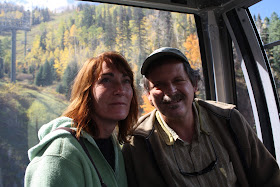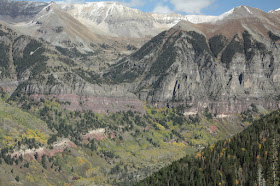On the same day that I took the photographs below (from near Kendrick Park), a National Weather Service aircraft took this aerial shot from southwest of Bellemont, AZ towards the northeast.

If you trace the line of these blow-downs you'll see that they trend between Kendrick Mt. on the center skyline and San Francisco Mountain on the right skyline.Therefore, these two parallel pathways are likely the southern portions of what I photographed on the ground farther northeast!
Original post:
You may or may not recall that northern Arizona and the Flagstaff area received national weather attention for a series of severe storms that raced across our region from north to south in the early morning hours of October 6. Perhaps 28 and at least 8 tornadoes were documented to have touched down in the area north and west of Flagstaff. While driving to and from the "Trail of Time Dedication" between Flagstaff and the Grand Canyon, I noticed unmistakable linear blow-downs of Ponderosa pine trees along US Highway 180 between here and the canyon. In at least three places the highway meanders across these awesome blow-downs. I stopped and photographed one of these sites on October 15, only 9 days after the event. The power of the wind on these huge trees is impressive!
 Most of the blown down trees are splayed towards the north documenting the direction that the wind was traveling. Highway 180 is seen in the background. This particular site is only 2 miles south of Kendrick Park.
Most of the blown down trees are splayed towards the north documenting the direction that the wind was traveling. Highway 180 is seen in the background. This particular site is only 2 miles south of Kendrick Park. Trees were blown apart at the seams. I saw many instances of severs breakage on small pieces of trees.
Trees were blown apart at the seams. I saw many instances of severs breakage on small pieces of trees. A tangled mess for sure but by the time I shot these photos the US Forest Service had already been here to remove debris from the highway and from on top of fences.
A tangled mess for sure but by the time I shot these photos the US Forest Service had already been here to remove debris from the highway and from on top of fences. The top of this tree was simply snapped and then blown about 50 feet away from its trunk.
The top of this tree was simply snapped and then blown about 50 feet away from its trunk. Many trees were snapped well above their base and I could see that most were snapped towards the north.
Many trees were snapped well above their base and I could see that most were snapped towards the north. I am sure glad I was not camping here when the tornado struck. It would have been like standing in front of a firing range.
I am sure glad I was not camping here when the tornado struck. It would have been like standing in front of a firing range. This huge root ball was forced over and took considerable soil with it as it was raised.
This huge root ball was forced over and took considerable soil with it as it was raised. This root ball lifted a fence from out of its place on the ground.
This root ball lifted a fence from out of its place on the ground. The roots were snapped on this tree as it fell over.
The roots were snapped on this tree as it fell over. The storms of October 6 were intense locally but apparently not all that rare around here. Meteorologists say that an average of four tornadoes strike Arizona each year. This single storm well surpassed that average.
The storms of October 6 were intense locally but apparently not all that rare around here. Meteorologists say that an average of four tornadoes strike Arizona each year. This single storm well surpassed that average.














































